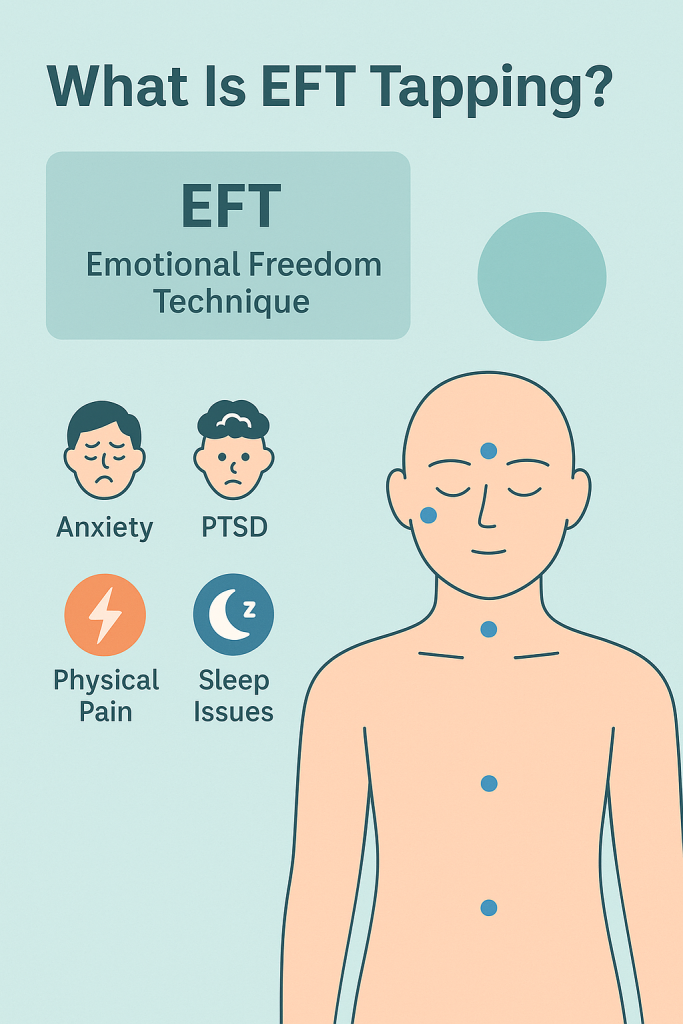An early morning walk into the park took me by surprise today. It was my first day in the park after I moved to the new city, in fact, a new country, altogether. Many people were tapping various parts of their bodies. When I came across the first person doing this, I thought he might be checking a paining muscle. However, as the number of people doing similar kinds of tapping increased, my urge to research this therapy took over. I had to stop and ask Google about tapping body parts. And like always, Google did not disappoint me. It never does.
What Is EFT Tapping?
This practice is known as Tapping Therapy, also referred to as Emotional Freedom Technique (EFT). It’s an alternative healing method used to treat symptoms like anxiety, PTSD, stress, and even some physical issues. EFT combines ancient Chinese acupressure with modern psychology. Interestingly, it was discovered by accident—and later backed by science.
A Quick Timeline of EFT
- 1980s: Dr. Roger Callahan first explored tapping to relieve psychological stress.
- 1990s: Gary Craig, one of his trainees, simplified the process and introduced EFT to a wider audience.
- 2000s: Researchers began validating EFT’s effectiveness for various health conditions.
- 2010s onwards: EFT became a global practice, recommended by professionals and embraced by individuals seeking alternative healing.
How EFT Works
EFT is not just about tapping randomly. It’s a structured technique that involves specific meridian points on the body, primarily the head and upper torso. As you tap, you focus on a particular emotional or physical issue you’d like to resolve.
The Science Behind It
Similar to acupuncture and acupressure, EFT works on energy meridians—channels through which energy, or “Qi,” flows. According to traditional Chinese medicine, blocked energy leads to illness. EFT aims to restore balance by tapping on key points, helping you heal both emotionally and physically.
Getting Started with EFT
Here’s how you can begin practicing EFT mindfully:
- Find a quiet space: Choose a calm, comfortable spot without distractions.
- Warm-up: Gently shake your body to release tension.
- Focus: EFT requires your full attention. Breathe deeply and stay present.
- Listen to your body: Adjust if you feel discomfort at any point.
EFT Tapping Basics
Here’s a step-by-step guide:
- Identify the issue: Choose one concern to focus on.
- Rate its intensity: Use a scale from 0 (no issue) to 10 (most intense).
- Create a reminder phrase: For example, “Even though I feel anxious while swimming, I deeply and completely accept myself.”
- Tap in sequence:
- Top of the head
- Beginning of the eyebrows
- Side of the eyes
- Under the eyes
- Under the nose
- Chin point
- Collarbone
- Under the arms
- Use two fingers to tap each point about five times. Tap both sides of the body if possible.
- Reassess intensity: After a round, rate the issue again. Repeat until the intensity reaches zero.

Who Can Benefit?
General Benefits of EFT
EFT is known to help with:
- Stress, anxiety, and depression
- PTSD
- Physical pain
- Muscle tension
- Sleep issues
- Food cravings
- Boosting energy and circulation
If you prefer natural healing methods over medication, EFT is a powerful tool.
EFT for the Elderly
EFT is helpful for seniors when combined with traditional care:
- Chronic pain relief
- Improved sleep (insomnia)
- Immune support
- Mental wellness (anxiety, depression, PTSD)
EFT for Children
Today’s kids face more emotional pressure than ever. EFT offers a gentle solution:
- Emotional processing: Helps kids identify and understand their feelings.
- Bedtime calm: Many parents now include tapping in bedtime routines.
- Support for nuclear families: Tapping can help kids who lack emotional outlets at home become more self-aware and emotionally resilient.
Are There Any Side Effects?
EFT is non-invasive and free from side effects. It’s safe even for people with allergies. However, if deep or overwhelming emotions arise, it’s best to consult a certified practitioner for guidance.
Tapping vs Meditation
Both meditation and EFT focus on mindfulness—but they differ. Meditation is passive and internal while EFT combines physical tapping with mental affirmations. This makes it easier for people who find meditation difficult. EFT allows for active emotional release and promotes deep healing by working through specific issues. In that way, tapping is like active meditation—engaging both mind and body to process pain, shift limiting thoughts, and accept yourself more fully.
In a Nutshell
EFT Tapping is an effective, alternative therapy for emotional and physical well-being. Backed by science and easy to learn, it’s now practiced by millions worldwide. Whether you’re dealing with anxiety, trauma, pain, or sleep problems, tapping might just be the healing technique you’ve been looking for.








Leave a Reply